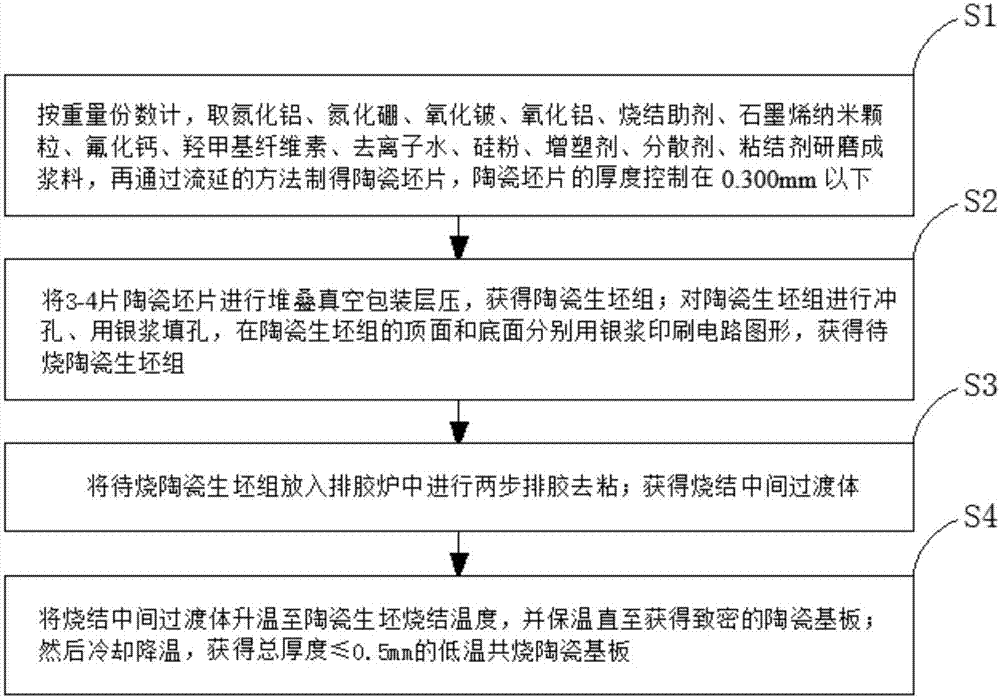Forming and sintering method of low temperature co-fired ceramic substrate
A technology of low-temperature co-fired ceramics and sintering method, which is applied in the field of semiconductors and can solve problems such as poor compactness, poor heat dissipation effect of ceramic substrates, and impact on service life, and achieve the effects of improving density, optimizing physical and chemical properties, and improving heat transfer
- Summary
- Abstract
- Description
- Claims
- Application Information
AI Technical Summary
Problems solved by technology
Method used
Image
Examples
Embodiment 1
[0023] Such as figure 1 As shown, the molding and sintering method of the low temperature co-fired ceramic substrate comprises the following steps:
[0024] Step S1. In parts by weight, take 64 parts of aluminum nitride, 30 parts of boron nitride, 10 parts of beryllium oxide, 30 parts of aluminum oxide, 15 parts of sintering aid, 2 parts of graphene nanoparticles, and 5 parts of calcium fluoride , 3 parts of hydroxymethyl cellulose, 15 parts of deionized water, 5 parts of silicon powder, 1 part of plasticizer, 1 part of dispersant, and 1 part of binder are wet ball milled for 2 hours to make a gel The ceramic slurry is vacuum stirred to defoam; the ceramic slurry after defoaming is cast to obtain a ceramic green sheet, and the thickness of the ceramic green sheet is controlled below 0.300mm;
[0025] Step S2. Stacking and laminating three pieces of ceramic green sheets in vacuum packaging to obtain a ceramic green body group; punching holes in the ceramic green body group, fi...
Embodiment 2
[0032] Such as figure 1 As shown, the molding and sintering method of the low temperature co-fired ceramic substrate comprises the following steps:
[0033] Step S1. In parts by weight, take 50 parts of aluminum nitride, 40 parts of boron nitride, 20 parts of beryllium oxide, 40 parts of aluminum oxide, 20 parts of sintering aid, 4 parts of graphene nanoparticles, and 15 parts of calcium fluoride , 6 parts of hydroxymethyl cellulose, 20 parts of deionized water, 10 parts of silicon powder, 1 part of plasticizer, 1 part of dispersant, and 1 part of binder are wet ball milled for 4 hours to make a gel The ceramic slurry is vacuum stirred to defoam; the ceramic slurry after defoaming is cast to obtain a ceramic green sheet, and the thickness of the ceramic green sheet is controlled below 0.300mm;
[0034] Step S2. Stacking and laminating 4 pieces of ceramic green sheets in vacuum packaging to obtain a ceramic green body group; punching holes in the ceramic green body group, fill...
Embodiment 3
[0041] Such as figure 1 As shown, the molding and sintering method of the low temperature co-fired ceramic substrate comprises the following steps:
[0042] Step S1. In parts by weight, take 57 parts of aluminum nitride, 35 parts of boron nitride, 15 parts of beryllium oxide, 35 parts of aluminum oxide, 18 parts of sintering aid, 3 parts of graphene nanoparticles, and 10 parts of calcium fluoride , 5 parts of hydroxymethyl cellulose, 17 parts of deionized water, 8 parts of silicon powder, 1 part of plasticizer, 1 part of dispersant, and 1 part of binder are wet ball milled for 3 hours to make a gel The ceramic slurry is vacuum stirred to defoam; the ceramic slurry after defoaming is cast to obtain a ceramic green sheet, and the thickness of the ceramic green sheet is controlled below 0.300mm;
[0043] Step S2. Stacking and laminating 3-4 pieces of ceramic green sheets in vacuum packaging to obtain a ceramic green body group; punching holes in the ceramic green body group, fil...
PUM
| Property | Measurement | Unit |
|---|---|---|
| thickness | aaaaa | aaaaa |
| particle diameter | aaaaa | aaaaa |
| thickness | aaaaa | aaaaa |
Abstract
Description
Claims
Application Information
 Login to View More
Login to View More - R&D
- Intellectual Property
- Life Sciences
- Materials
- Tech Scout
- Unparalleled Data Quality
- Higher Quality Content
- 60% Fewer Hallucinations
Browse by: Latest US Patents, China's latest patents, Technical Efficacy Thesaurus, Application Domain, Technology Topic, Popular Technical Reports.
© 2025 PatSnap. All rights reserved.Legal|Privacy policy|Modern Slavery Act Transparency Statement|Sitemap|About US| Contact US: help@patsnap.com

